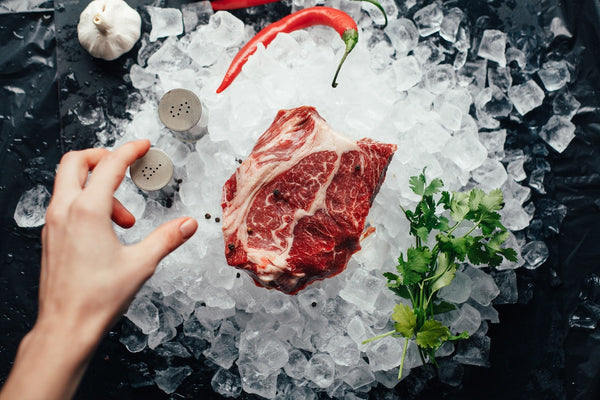Is grass-fed beef healthier for you? Yes, if you’re looking for meat that packs more nutrition, a better fat profile, and is less likely to contain “superbugs” (harmful, antibiotic-resistant bacteria).
Whether a thick steak or savory meat snack, shopping for beef requires decisiveness. Do you want prime, choice, or select? Dry- or wet-aged? The options are vast.
Not knowing what you're looking for can lead to a cut that’s dry, lacking flavor, or full of unhealthy additives.
To help you buy and eat better beef, we’re highlighting one of the key differences — grass-fed or grain-fed beef.
What Is Grass-Fed Beef?
It's important to preface this by stating there's no standard definition of grass-fed beef — at least not one that the USDA officially recognizes.
The majority of cows are grass-fed for the first part of their life. A calf grows while happily roaming a pasture, grazing on grass, and drinking its mother’s milk. However, once the cow hits a certain size or age (usually 650-700 pounds, or 12 months old), their lives shift.
Ideally, cattle are left in their natural habitat for their entire lives. Allowing them to continue roaming and foraging freely is not only less stressful, more sanitary, and better for their overall health, it’s also more humane. The result is grass-fed or pasture-raised beef, as well as grass fed or pasture-raised dairy.
On the other hand, a cow can also get transferred to a feedlot where they are kept in crowded confines and fed a high-grain diet of corn or soy with added roughage from stalks, hay, or other grains. This is washed down with a cocktail of growth hormones and antibiotics to keep the cows from getting sick, a high likelihood given their concentrated quarters.
A far cry from chewing the cud, the cow is now fattened more quickly and at a lower cost. After about six months, the cow reaches the ideal weight and is grain-fed beef.
All cows have technically been grass-fed for the first part of their lives. But to reap all the benefits of eating grass-fed beef, make sure you buy 100% grass-fed and grass-finished beef — these two labels indicate that the cow was fed grass for their entire lifespan, not just while they were young.
Note that beef producers need to apply to the USDA’s Food Safety Inspection Service before adding any labels like “grass-fed,” “raised without antibiotics” (RWA), “organic,” or “free-range.” However, the USDA no longer sets the standards for these terms — it's the producer’s responsibility to define them clearly on the label, and the consumer’s right to research the company thoroughly before buying beef.
Organic Does Not Mean Grass-Fed (and Vice Versa)

Organic, grass-fed, pasture-raised, free-range — all these are good, but they are also independent of one another.
Though without standard definitions, these terms are applied in a very systematic manner. An organic label only means that the cow was raised using organic practices, specifically that no pesticides, hormones, or other non-organic substances were added to its feed. It doesn’t, however, encompass what that organic feed contained or where it was consumed. Conversely, grass-fed only means that the cow was grass-fed. Whether the grass was organic or consumed in a pasture is not considered.
The terms “pasture-raised” and “free-range” tell you that the cows enjoyed their time outside — but did not necessarily eat grass.
If you’re looking for grass-fed, organic, or free-range in particular, make sure it’s stated on the label. Or better yet, find out how the brand or the farm operates. A question at a farmer’s market stall or a browse through your favorite brand’s website should reveal all the information you want.
Grass-Fed Beef Takes Time and Effort
The journey to producing 100% grass-fed beef is time-consuming and costly — two traits that can lead to a producer’s downfall in the beef industry.
Raising cattle that’s grass-fed requires at least 1-2 acres for every cow. However, grain-fed cattle only occupy the space for about 12 months, while grass-fed or grass-finished cattle do so for their entire lives, which is generally about 18-24 months for beef cattle.
Plus, since grass-fed cows naturally get more exercise and no added growth hormones, they end up smaller and yield less meat than their carbo-loading counterparts.
Spending double the time and space to produce less meat is not a choice many beef producers are financially able or willing to make.
So despite the rising demand for high-quality, grass-fed beef, the supply in the United States is still surprisingly low — only about 5% of the country's cattle production is grass-finished.
The Benefits of Grass-Fed Beef
As with any product, higher production costs mean higher consumer prices. And in the case of grain-finished versus grass-finished beef, this means anywhere from $2-$10 more per pound for the latter.
But people are willing to pay the price — not just at the grocery store, but also at restaurants, where grass-fed beef dishes have started appearing on menus.
The main benefit of grass-fed beef is added nutrition. Having lived on a natural diet of greens, and having received no antibiotics or hormones — essentially a raw, gluten-free, and macrobiotic diet — grass-fed cows are as healthy as they come.
This results in beef that packs in more antioxidants and nutrients, including Vitamin A and Vitamin E, and less calories, cholesterol, and saturated fat. The fat in grass-fed beef includes heart-healthy fats, specifically conjugated linoleic acid (CLA) and Omega-3 fatty acids.
Although CLA is naturally found in meat and dairy, grass-fed beef contains much greater levels than grain-fed beef. This is significant, as CLA is a polyunsaturated fatty acid that our bodies can’t produce on their own, and has been known to help prevent cancer and heart disease.
Omega-3, on the other hand, is usually found in fish, nuts, and seeds, and offers a ton of potential health benefits not commonly attributed to everyday beef eating — healthier bones, joints, and skin, plus lowered blood pressure, decreased inflammation, improved mental health and brain functioning, and protection against autoimmune diseases.
Grass-fed beef practices are also more humane and healthier for cows overall. There’s no excessive use of antibiotics, which is a staple for grain-fed cows in order to prevent diseases caused by an unnaturally high calorie diet and unnaturally close quarters. Unfortunately, grain-fed cows have developed antibiotic resistance, and the new bacteria strains are even harder to control.
How to Cook and Enjoy Grass-Fed Beef

When it comes to taste, it helps to think of grain-fed and grass-fed beef as completely different. Grain-fed beef is what we are most familiar with — marbling with a rich texture and an almost sweet taste. Grass-fed beef, in contrast, has a chewier texture and gamier, slightly grassy flavor.
The two types of beef also cook differently. With a much leaner composition, grass-fed beef cooks faster than grain-fed or other conventional beef, going from perfect to overcooked in seconds. To make a grass-fed steak as juicy as possible, you need to first season the meat, pat both sides dry, and cook using a high-heat oil (i.e. avocado oil or extra-light olive oil) and low temperatures.
Use a thermometer to check when the beef is done — 130-135° Fahrenheit for medium-rare — and make sure to let your beef rest for at least 6-10 minutes. This will allow the natural juices to redistribute in the meat.
And of course, pair your nutritious grass-fed meat with equally nutritious sidings. Top your ground beef patty with some avocado and tomato, plate slices of rye sourdough alongside your ribeye, and sprinkle some all-natural jerky or biltong on top of your breakfast eggs. Yes, grass-fed beef is healthier for you and is even better when part of a complete healthy diet.
Grass-fed Beef: The Greener Choice
There are a number of reasons to reach for grass-fed beef. Not only is it significantly healthier for consumers, it’s also better for the cattle. The move from grain-fed to grass-fed is a significant one. And thankfully, with so many new options on the market, it’s a delicious and healthy one.

